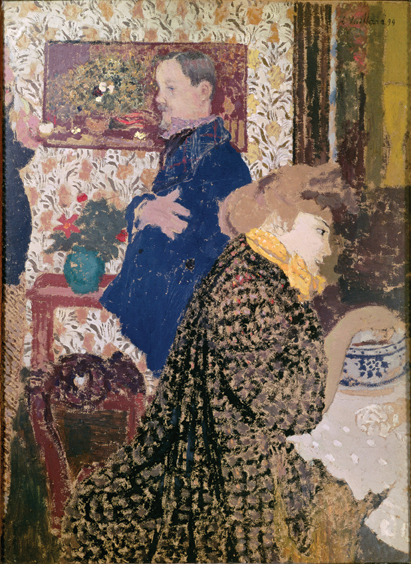Interior Monologues
Édouard Vuillard (1868–1940) lived a long and astonishingly productive life. Actually, several lives: painter, printmaker, decorator, portrait painter, stage-set designer, and photographer (he used a Kodak box camera).
As these two exhibitions show, he was the very model of the 19th-century artist: he worked hard and incessantly and cultivated (especially after 1900) a select, well-connected audience that he

Édouard Vuillard, Misia and Vallotton at Villeneuve, 1899, oil on cardboard, 283⁄8" x 207⁄8". The Jewish Museum. Collection of William Kelly Simpson
supplied with intimate portraits, sidestepping the bombast of traditional portraiture and depicting his subjects in their own relaxed setting—well-off people at home. The brothers Henri and Marcel Kapferer may have been captains of industry, but in 1912 Vuillard painted them at lunch, sharing their table with what was, even then, the indispensable telephone.
The picture that greets the visitor to the Jewish Museum show, subtitled “A Painter and His Muses, 1890–1940,” is the Met’s 1889 Self-Portrait with Waroquy. This small canvas is deceptively complex because Vuillard painted himself and his friend as they are reflected in a mirror, a fact we notice only when we look carefully at the way the objects in the lower right appear as double exposures. Vuillard here, and throughout his career, was analyzing how we see things, not in the scientific way the Impressionists studied light, but working within an esthetic framework, showing how things undergo a metamorphosis within the work of art. The self-portrait links the works in the Jewish Museum to the paintings and drawings in the recent Jill Newhouse show, which included a preliminary study for the painting.
Vuillard and the Nabis, Maurice Denis especially, may have flattened perspective in their paintings, may have seen Gauguin’s unnatural colors as an inspiration for their own flight from realism, and may certainly have copied the way fabrics blend with backgrounds in Japanese woodblock prints, especially the erotic shunga prints that fuse kimonos and bodies. But Vuillard truly came into his own in the 1890s, when he used perspective to enhance the unreality of his muted colors and melting bodies. Marie Opening the Window (1891), showing the artist’s sister reenacting a 17th-century Dutch motif, raising a window and extending her hands almost outside the frame of the picture, marks that transition.
Woman in Striped Dress (1895), from “The Album,” and Misia and Vallotton at Villeneuve (1899) are two more masterpieces of the 1890s at the museum. The billowing blouse dominates the composition of the first, engulfing the two women arranging chrysanthemums, while the seemingly casual picture of Misia (one of Vuillard’s muses, along with his mother and Lucy Hessel), the artist Vallotton, and Misia’s almost invisible husband (reduced to pipe and paunch at left) is not only one of the many portraits of artists Vuillard painted but another experiment with the artificial world of domestic interiors, with their mirrors, controlled lighting, and unreal color.
This ingenious manipulation of human space dominated Vuillard’s career. We see it again in two large 20th-century paintings: The Sewing-Party at Loctudy (1912), at Newhouse, and the portrait of Marcelle Aron (1914) seated on a sofa turned at an improbable angle, again with a mirror in the background. Both play with and distort the very rooms where in all likelihood the pictures would be displayed. Vuillard turns the site in “site-specific” into total artificiality, that is, art.
A painter whose existence is defined by French culture, Vuillard shows the magic of art for the sake of art.
By Alfred Mac Adam
Source: http://www.artnews.com